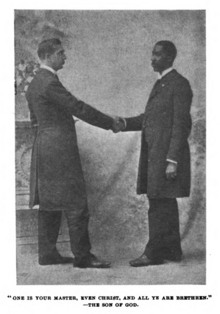Contents

Norman Barton Wood (1857–1933) also known as N. B. Wood,[1] was an American author, lecturer, and Baptist minister. He was White, and wrote books about African Americans[2] and Native Americans in the late 19th-century and early 20th-century.[3] He lived in Aurora, Illinois.
Early life and education
Wood was born on August 18, 1857, in Fayette County, Kentucky, U.S., to parents Narcissa (née Wheat) and Benjamin Wood.[4] He attended the Southern Baptist Theological Seminary in Louisville, Kentucky, and studied under Rev. William Heth Whitsitt.
Career
Wood was a minister in the Baptist church.[3][5] He served as pastor at the Claim Street Baptist Church in Aurora, Illinois.[6] In 1898, he served as the chairman of the Temperance League in Aurora, Illinois.[7]
He co-authored the book about the Black struggle in the early 20th-century with Booker T. Washington and Fannie Barrier Williams, A New Negro for a New Century: An Accurate and Up-to-Date Record of the Upward Struggles of the Negro Race (1900).[2] It contains stories about Black history, journalism, slave narratives, biographical sketches, and stories from Black soldiers who fought in U.S. wars.[8] Much of the book A New Negro for a New Century is rooted in late 18th-century ideas about race, and is considered to be outdated racial theory in the 21st-century.[2][8] The book may have been written in order to refute claims made by President Theodore Roosevelt in Scribner's Magazine in 1899 about "racial fitness"[2] or possibly in order to move the dialogue passed popular 18th-century Black stereotypes, such as fictionalized plantation stories, vaudeville, and "scientific racism".[8]
Wood dedicated some 20 years to researching, lecturing and writing about Native Americans,[3] including his book Lives of Famous Indian Chiefs: From Cofachiqui, the Indian Princess, and Powhatan, Down to and Including Chief Joseph and Geronimo (1906). The book includes an image of Wood seated with his books accompanied by the caption, "Yours to 'Take up the White Man's Burden'" and his signature Norman B. Wood.
Wood died of a heart attack on December 25, 1933, in Aurora, Illinois.[3] He was interred at the Naperville Cemetery in Naperville, Illinois.[3]
Publications
- Wood, Norman B. (1897). The White Side of a Black Subject: A Vindication of the Afro-American Race, From the Landing of Slaves at St. Augustine, Florida, in 1565, to the Present Time. Chicago, IL.: American Publishing House.[9]
- Washington, Booker T.; Wood, Norman B.; Williams, Fannie Barrier (1900). MacBrady, John E. (ed.). A New Negro for a New Century: An Accurate and Up-to-Date Record of the Upward Struggles of the Negro Race. Chicago, IL: American Publishing House.
- Lives of Famous Indian Chiefs: From Cofachiqui, the Indian Princess, and Powhatan, Down to and Including Chief Joseph and Geronimo. Aurora, IL.: American Indian Historical Pub. Co. 1906.
References
- ^ Jenkins, Tammie (10 August 2021). The Haitian Revolution, the Harlem Renaissance, and Caribbean Négritude: Overlapping Discourses of Freedom and Identity. Rowman & Littlefield. p. 56. ISBN 978-1-7936-3379-8.
- ^ a b c d Bay, Mia (2000). The White Image in the Black Mind: African-American Ideas about White People, 1830–1925. Oxford University Press. p. 215. ISBN 978-0-19-510045-7.
- ^ a b c d e "Rev. N. B. Wood Indian History Authority, Dies". Chicago Tribune. 27 December 1933. p. 12. ISSN 1085-6706 – via Newspapers.com.
- ^ "Wood, Norman B. (Norman Barton), 1857–1933". LC Linked Data Service: Authorities and Vocabularies, Library of Congress. Retrieved 19 October 2023.
- ^ "Bible Class Met With N. B. Wood". Aurora Daily Star. 2 February 1924. p. 41. OCLC 54841406 – via Google New Archive.
- ^ "Social and Personal". Aurora Daily Express. 29 January 1901. p. 3.
- ^ "Society and Notices". Aurora Daily Express. 9 September 1898. p. 3. OCLC 54841406 – via Google News Archive.
- ^ a b c Gates Jr., Henry Louis; Jarrett, Gene Andrew (8 June 2021). The New Negro: Readings on Race, Representation, and African American Culture, 1892-1938. Princeton University Press. p. 10. ISBN 978-1-4008-2787-9.
- ^ "Daily Express". Aurora Daily Express. 30 April 1895. p. 3. OCLC 54793779 – via Google News Archive.
External links
- Norman Barton Wood at Find a Grave, which has images of his grave

